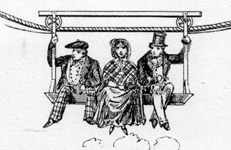The Girnoc Farms
Past Research
Location Map
Gordon Tombstones
Sources
Home
The Gordons O' Girnoc



They had one child:
1. James (Born in 1824 at Bovaglie.)
Barbara had many suitors, including a number of men of some social standing. However, Barbara or Babby as she was known locally, decided to marry an older man, a widower without children, Peter Frankie. He was good-looking, smart,and had what was considered to be an excellent job, - gamekeeper at Aitnaguisach. The marriage took place in 1824. The couple stayed a few days at Babby's father's until the keeper's house was renovated and made a number of visits in the area.
One Sunday the popular couple were invited to the Smart's at Abergeldie Mains. Early in the afternoon they left George Brown's house and crossed the Dee. The water was high but not in spate. There was no bridge at Abergeldie, only a wooden 'Cradle'. A heavy cable was wound round a windlass on both banks and on it ran the 'Cradle', with two grooved wheels. The 'Cradle' was only three planks held by iron hoops and curved like cradle rockers. On both ends there was an upright, joined by a cross-bar. The seating was for two, and the 'Cradle' was usually worked by the Abergeldie gardener.
"It was a Sunday afternoon that they gaed across at the cradle. The water was na' what ye would ca' in flood, but far ower big for wadan' in ony place, for there had been a good sup rain the nicht afore. After supper time (9 pm.) some o' our folk chanced to be out about the doors -and came in cryan'"
After the couple had spent a happy afternoon they left the Castle side of the river about 9 pm. By that time the water was higher. It appears that there was a fault with the windlass and the rope broke, throwing both occupants into the river. It was a dark night and people, including old George, searched the river bank with burning torches. It was not until daybreak that Babby's body was found, while Frankie was found a week later, at Coilacreich. According to one local story, the gardener-winchman was also drowned, although he does not appear in Janet's version of the tragedy. The whole area was in mourning.
"Men, men! there's something nae richt about the cradle. There 's lichts ga'an up an' down the water in a fearsome, like' way. Run, run, an' see that naething has happened"
We that were men were aff in a minute, and the rest soon followed, but there was some folk nearer at han' there afore us.
"I'll never forget that night - Women no kenan' what do, runnan' about, an' cryan."
"Oh! Can naething be done, can naething be done? Babby Brown 'a lost ! Babby Brown 's lost!" And the folk at the Castle and the Mains wi' lichts an' lanterns runnan' here and there on the ither side, and cryan' across. I saw in a moment what had happened; for there was the rope floatin' down the water. The nicht was vera dark but I an', two or three ither young fellows took a hand o' ither's hands, and in we jumped to try to get at the rope thinkan' they might still be haudan' on to it. The stream was awfu' strong, and we had enough ado to keep our feet. At last we reached it; but there was naething there - neither sicht nor soun', but the sough o' the water ga'an swirlan', swirlan' down.
A' hope o' recoveran' them alive was now at an end, but we could na' go hame. The hail countra' was soon gathered; but what could they do? Down, down the water edge they wandered, peeran' into the dark stream to see if they could notice onything tumblan', or ony sight o' the lost bodies. Oh, it was a waesome night!
There was an enquiry, but no explanation was ever given. What caused the rope to break will never be known. George Brown died four years later. His grave is in Crathie Kirkyard. In 1885 the 'Cradle' was replaced by a bridge.
Peer' auld George! It would hae melted a heart o' stane to hae seen him, seldom speakan' a word to onybody; but what he did say was like a meek an' humble christian, as he' was. Now and then he would step close up to the water edge as gin something had caught his sight in the stream; but we a' kent it was only to hide his grief, for instead o' lookan' into the water he would bring the corner o' his grey plaid up to his een an' mony's the saut tear that fell into't that sorrowfu' night.
"She was my favourite bairn, and fain would I that Thou hadst spared her whilst Thou wast pleased to spare me, but not thy will, but Thine be done.'
I When I saw - him next I could na' but think he was less waesome than afore.